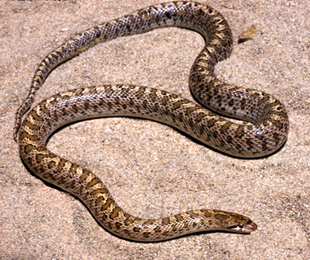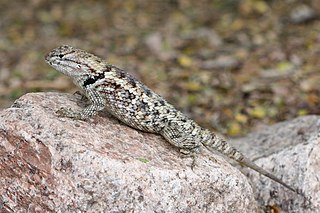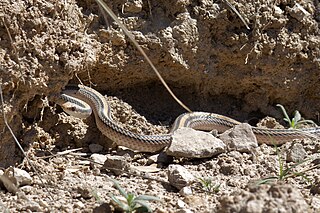
Spiny lizards is a common name for the genus Sceloporus in the family Phrynosomatidae. The genus is endemic to North America, with various species ranging from New York, to Washington, and one occurring as far south as northern Panama. The greatest diversity is found in Mexico. This genus includes some of the most commonly seen lizards in the United States. Other common names for lizards in this genus include fence lizards, scaly lizards, bunchgrass lizards, and swifts.

Arizona elegans is a species of medium-sized colubrid snake commonly referred to as the glossy snake or the faded snake, which is endemic to the southwestern United States and Mexico. It has several subspecies. Some have recommended that A. elegans occidentalis be granted full species status.

Sceloporus magister, also known as the desert spiny lizard, is a lizard species of the family Phrynosomatidae, native to the Chihuahuan Desert and Sonoran Desert of North America.

Sceloporus poinsettii, the crevice spiny lizard, is a species of small, phrynosomatid lizard.

The granite spiny lizard is a species of lizard in the family Phrynosomatidae.

The long-nosed snake is a species of nonvenomous snake in the family Colubridae. The species is endemic to North America. It has two recognized subspecies. The other species in the genus were previously considered subspecies.

Holbrookia maculata, commonly known as the lesser earless lizard, is a species of lizard in the family Phrynosomatidae. The species is native to the southwestern and central United States and northern Mexico. There are eight recognized subspecies.

Sceloporus grammicus is a species of lizard from Mexico and the southern United States. It is sometimes referred to as the mesquite lizard or graphic spiny lizard.

Sceloporus merriami, commonly known as the canyon lizard, is a species of lizard in the family Phrynosomatidae. The species is native to the south-western United States and northern Mexico.

Sceloporus serrifer, the rough-scaled lizard or Yucatecan rough-scaled lizard, is a species of phrynosomatid lizard.

Sceloporus variabilis, commonly known as the rose-bellied lizard, is a species of lizard which is found from Central America to southern Texas

Sceloporus merriami annulatus, commonly known as the Big Bend canyon lizard, is a subspecies of the canyon lizard, and is endemic to southwestern Texas and adjacent northeastern Mexico.

Salvadora hexalepis, the western patch-nosed snake, is a species of non-venomous colubrid snake, which is endemic to the southwestern United States and northern Mexico.

Sceloporus occidentalis bocourtii, commonly known as the Coast Range fence lizard, is a subspecies of Sceloporus occidentalis, the Western fence lizard.

Senticolis is a genus of nonvenomous snake in the family Colubridae. The genus Senticolis is monotypic, containing the sole species Senticolis triaspis, also known as the green rat snake. The species is endemic to Central America, Mexico, southern Arizona, and southern New Mexico.

The Madrean alligator lizard is a species of lizard in the family Anguidae. The species is endemic to the southwestern United States and adjacent northwestern Mexico.

Slevin's bunchgrass lizard is a species of lizard in the family Phrynosomatidae. The species is indigenous to the southwestern United States and adjacent northern Mexico.
Sceloporus gadoviae, also known commonly as Gadow's spiny lizard and la espinosa de Gadow in Mexican Spanish, is a species of lizard in the family Phrynosomatidae. The species is endemic to Mexico.

Sceloporus lundelli, also known commonly as Lundell's spiny lizard and la espinosa de Lundell in Mexican Spanish, is a species of lizard in the family Phrynosomatidae. The species is native to the Yucatán Peninsula in Mexico, Belize, and Guatemala. There are two recognized subspecies.





















